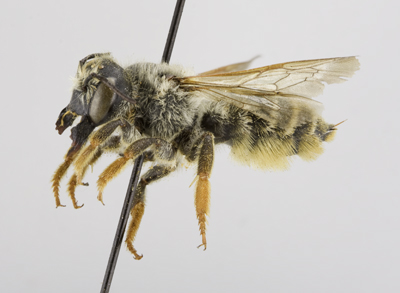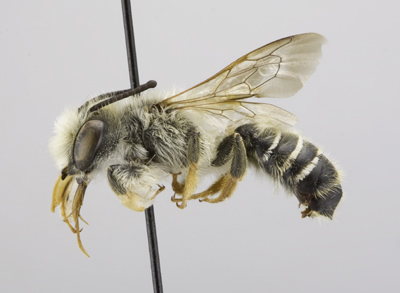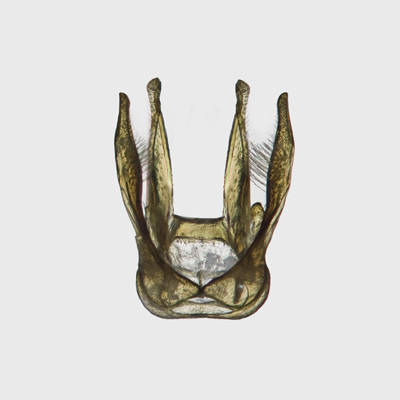
28. Megachile (Sayapis) mellitarsis Cresson, 1878
Megachile mellitarsis Female |
Megachile mellitarsis Male |
Megachile mellitarsis Cresson, 1878. Trans. Amer. Entomol. Soc. 7: 121 (♂).
Megachile terrestris Cockerell, 1908a. Ann. Mag. Nat. Hist. (8) 1: 260 (♀) (preoccupied).
Megachile geophila Cockerell, 1908b. Can. Entomol. 40: 460 (replacement name for M. terrestris Cockerell, 1908a, not Schrottky, 1902).
Diagnosis.The female of M. mellitarsis can be recognized by the combination of the clypeus with apical margin with prominent triangular tubercles, and the bright reddish brown tarsi which contrast the black tibiae and femora. The male of M. mellitarsis can be recognized by the combination of 3-dentate mandibles, T5 without white apical fascia, the front basitarsus with boat-shaped dilation elongated apically and extending to apex of 3rd tarsomere, and the bright reddish brown tarsi which contrast the black tibiae and femora. They are most similar to M. fidelis and M. pugnata, both which have T5 with white apical fascia and have the boat-shaped dilation extending at most as far as the middle of 2nd tarsomere.
FEMALE: Length 11-14 mm.
Head:
Figure M28: Megachile mellitarsis female mandible |
1) compound eyes slightly convergent below; lateral ocelli subequally distant from eyes and edge of vertex, 2) clypeal margin with a moderately deep, rounded emargination on each side of medially produced apical rim, with lateral prominences triangularly produced, apical rim shiny and impunctate, 3) mandible 4-dentate, with an incomplete cutting edge between the 2nd and 3rd teeth (Figure M28), 4) gena broader than compound eye (5:3), 5) punctures fine and crowded over entire head, slightly separated on vertex laterally, shiny and impunctate areas on clypeus adjacent to tentorial pits, 6) pubescence relatively long, whitish on gena, partially concealing surface, becoming pale yellow on vertex and laterally, and on clypeus, more dense on face around antennae, supraclypeal area, and paraocular area (in some specimens, whitish hair over entire head), 7) F1 slightly longer than broad (3:2.3), longer than pedicel, which is about as long as broad, and very slightly longer than F2, which is slightly longer than broad, remaining flagellomeres longer than broad (3:2), apical flagellomere slightly more elongate (3.5:2).
Mesosoma:
1) pubescence whitish to pale yellow, with no dark admixture, equally long and dense over entire surface, including laterally, below and on propodeum, but surface of discs entirely visible, 2) punctures fine and crowded, propodeum with fine, shallow punctures which are separated by 1 pd, triangle dull and impunctate, 3) hind basitarsus distinctly shorter and slightly narrower than its tibia, spurs and all tarsi pale reddish-brown, contrasting with the otherwise dark leg segments, 4) tegula uniformly punctured throughout, 5) wings transparent yellowish, more brownish apically, the veins reddish-brown.
Metasoma:
1) elongate and parallel-sided; T2-T4 deeply grooved basally and quite deeply depressed apically, T6 slightly convex in profile to the rather abrupt apical lip; punctation very fine, crowded basally, but becoming more distinct to T5, very fine and crowded on T6; T1-T5 with rather conspicuous entire whitish apical fasciae, pubescence on discs pale yellow, 2) S6 rounded; scopa entirely pale yellowish; punctures coarse and close on basal sterna, becoming more wide spaced on apical sterna, well spaced medially on S6.
MALE: Length 11 mm.
Head:
1) compound eyes slightly convergent below; lateral ocelli subequally distant from eyes and edge of vertex, 2) clypeal margin slightly outcurved, faintly crenulate medially with a shiny, impunctate apical rim, 3) mandible 3-dentate, lower process acute, submedian in position, 4) gena subequal to compound eye in width; with a bare shallow, shiny concavity at lower angle, the lower margin of which is produced into a flattened triangular spine with an apical tuft of hair, 5) punctures very fine and close over most of head, but quite distinctly separated on vertex laterally, 6) pubescence entirely pale, without dark admixture, more yellowish on vertex, elongate on clypeus and supraclypeal area, hiding the surface, 7) F1 about as long as broad, and subequal in length to pedicel, and shorter than remaining flagellomeres, which are longer than broad (3:2), apical flagellomere flattened and quite broadly dilated.
Mesosoma:
1) pubescence entirely pale, front tarsal fringe white, tipped with golden-brown beneath, 2) punctures very fine and close over most surfaces, propodeum with punctures well spaced medially (> 2 pd), triangle smooth and impunctate, 3) front coxa bare anteriorly, with three or four contiguous long suberect red bristles just in front of long slender spine, spine with short appressed red bristles in apical half; front femur slender and black; front tibia black except for yellowish apical tip; front tarsus yellow, broadly dilated and flattened, tarsomere 2 with a dark spot ventrally, the basitarsus slightly shorter than the two following tarsomeres combined, but its anterior margin produced into an extremely large and deeply hollowed scale that is narrowly produced apically nearly to the tip of tarsomere 3, the inner margin broadened apically so it overlies the concavity in part, the outer margin slightly flexed at this point; mid and hind tibiae black except apically, mid and hind tarsi reddish-brown, spurs yellow, 4) tegula rather smooth in posterior half, finely punctate anteriorly, 5) wings yellowish-hyaline, more distinctly clouded apically, the veins reddish-brown.
Metasoma:
1) parallel-sided, T3-T5 distinctly depressed apically, more so toward sides; carina of T6 with median emargination small to inconspicuous, often obscured by irregular spines or crenulations at each side, a deep pit just above carina, apical margin of T6 with no evident median or lateral teeth; T7 rounded to slightly triangular apically with a concavity just above apex; punctures very fine and close on basal terga, deeper and more distinct on the more shiny apical terga, but still rather close, T6 finely rugosopunctate; discal pubescence pale to yellowish, sparse and slightly darker on apical terga, T2-T4 with narrow entire white apical fasciae, fascia lacking on T5, 2) S1-S4 exposed, rather dull but very minutely and regularly punctate, punctures well separated, apical margin depressed and yellowish-hyaline, that of S4 very slightly incurved across median area, apical margins with long pale hairs especially laterally, though hardly forming fasciae, discal pubescence sparse and pale, not obscuring surface.
Genitalia: Figure G28.
|
Figure G28: Megachile mellitarsis genitalia |
Discussion:
This distinct species is uncommon in Canada, restricted to southern BC. Little has been reported on its biology, including on its nesting preferences (Table 1).
Distribution:
Southern BC (see Map 28).
|
Map 28: Canadian distribution of Megachile mellitarsis |




